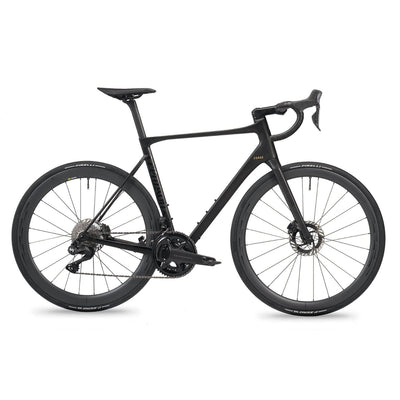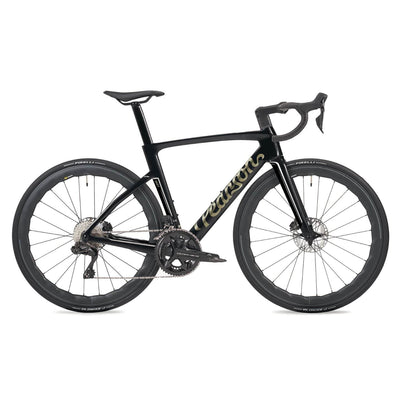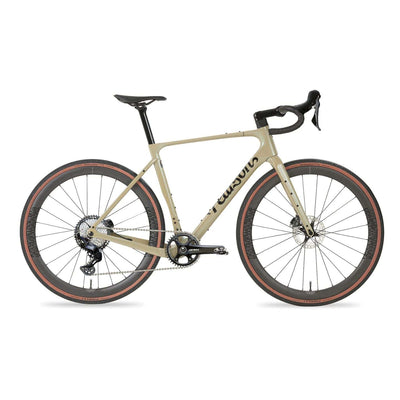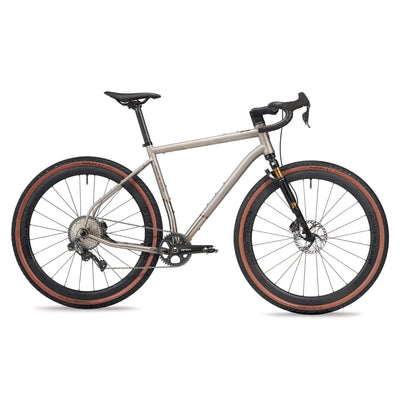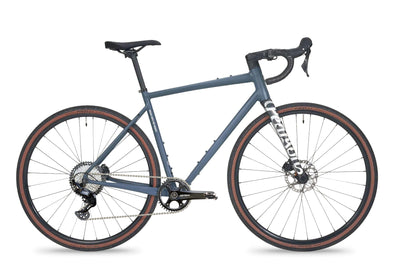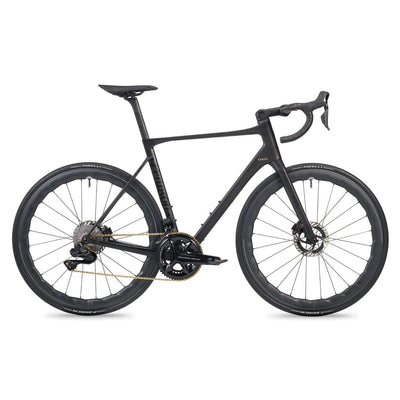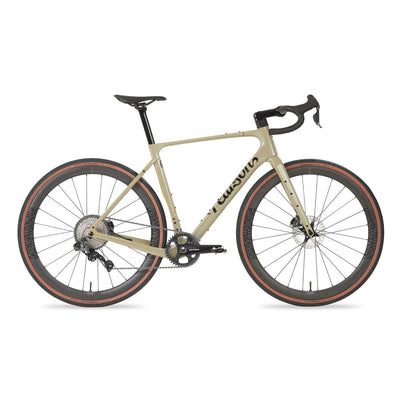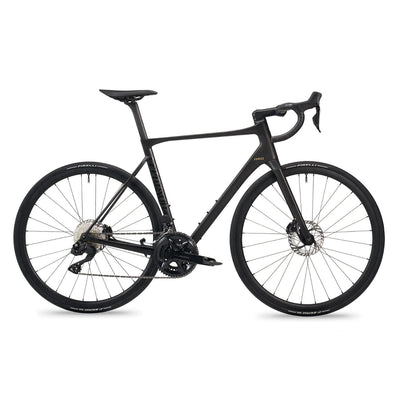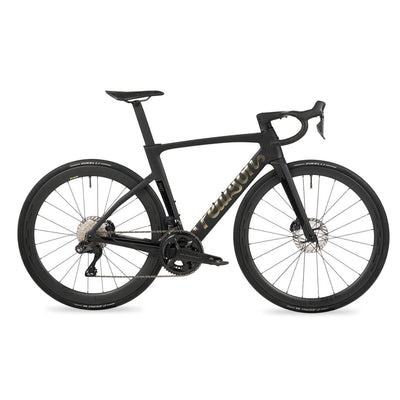THE BRAKE REVOLUTION
It’s not so long ago that disc brakes were treated with horror by road cyclists, with the pros staging protests and refusing to use them. But a few years later they’re standard kit on almost all new bikes. What’s changed and why are disc brakes a good option for all performance machines?

Disc brakes have a lot of advantages over rim and other types of brakes, which is why they’re the standard way of slowing down and stopping pretty much every form of wheeled transport.
In a disc brake, pads of high friction material housed in a brake calliper attached to the bike frame are pressed against both sides of a metal rotor that’s bolted to the wheel axle, with the friction produced generating heat and slowing the bike down. Bike disc brakes are most usually actuated hydraulically via a hose from the brake lever that operates pistons in the brake calliper to force the brake pads against the rotor.
Lower priced bikes often use mechanically operated disc brakes where a cable connects the brake levers to the callipers, with a lever arm pressing the pads into the sides of the rotor.
Disc brakes - what are the advantages?
The primary advantage of a disc brake over a rim brake is more consistent braking whatever the weather; on a wet day you won’t be left waiting for the brake pads to cut through a layer of water before anything happens.

You’ll also usually get more powerful braking overall and better modulation of braking force than with a rim brake.
The flip side is that disc brakes work out heavier than rim brakes, principally due to the metal rotor. But that weight disadvantage is less than you’d think once you take account of the whole system weight for the bike.
Disc brake wheels are now routinely held in the frame by screw-in thru-axles rather than the quick releases used by rim brake wheels. That gives a much more rigid interface between the bike frame and the axle, which has allowed bike makers to pare down the frame while still retaining its rigidity.
The same is true of wheels. The need to build in a braking surface and for the rim to fit within the brake arms constrained the shape and width of the wheel rim. That’s now gone with braking moved to the disc brake rotor, letting wheel designers produce wider, more aero rims that are also lighter and ushering in the modern trend for wider tyres run at much lower pressures so that riding has become a lot more comfortable.
In a rim brake wheel, the wheel’s rim has to hold the pressure of the tyre, handle the inward force of the brake pads and deal with heat build-up; in a disc brake wheel it’s only the first of these which is still relevant.

Heat and rim wear were always the bane of rim brake carbon wheels. Mavic has said that over 70% of wheel failures that occurred when it was providing Neutral Service for the Etape du Tour a few years ago were in rim brake carbon clinchers, where dragging the brakes on long descents had literally caused the rim to melt. Newer high iTg resins deal with heat better and new treatments of the braking surface have improved braking performance, particularly in the wet, but rim brake carbon clincher wheels are still no match for disc brakes.
Disc brakes have other advantages for bike designers. Unlike cables, the hydraulic fluid in the brake hose is not prone to friction, so it’s possible to route a brake hose through very tight turns, which along with the shift to electronic groupsets on high end bikes has made internal cable routing through the bars, stem and headtube an option, without degrading performance. It’s also easier to shield a disc brake from the airflow than a rim brake, so aerodynamics have improved.
Disc brake standards

Road bikes were late adopters of disc brakes, which had been a feature of mountain bikes for years. The original crop of disc brake road bikes followed the MTB post mount brake standard, where there’s a gap between the brake calliper and the frame. With aerodynamics much more important to road bike riders, post mounts were quickly superseded by flat mount disc brake callipers. Originated by Shimano, flat mount callipers provide a much lower profile, cleaner looking interface between the brake and the frame and it’s easier to make aerodynamic. It’s the brake standard used on all our disc brake bikes with the exception of the Flat Iron urban bike.
Disc brake rotor sizes vary, with rotors on downhill mountain bikes going as large as 220mm. For road bike use, 160mm is the norm and SRAM road groupsets only come as standard with this size although it does sell 140mm rotors. Shimano gives you more options, with its rotors for road bikes coming in 140mm and 160mm diameters. You’ll occasionally find a 180mm rotor on the front of a gravel bike.
A 160mm rotor gives you 30% more braking surface than a 140mm rotor, which helps with heat dissipation, which can be an issue with disc brakes on long descents. Excess heat can cause the rotor to warp and even, at the extreme, boil the hydraulic fluid. So Shimano, for example, has specific features built into its rotors which it calls Freeza to help scrub heat.

Almost all road bike disc rotors adopt a floating rotor design, where the outer part of the rotor with the braking surface is attached to a carrier. This allows the rotor to expand more evenly as it heats up, which results in lower deformation and less chance of rubbing. Often rotors are made of a sandwich of steel faces with an alloy centre, which helps with heat dissipation and higher spec rotors will have rounded edges rather than sharp ones to lower the risk of injury.
Shimano’s latest 12-speed Dura-Ace and Ultegra groupsets use a standard-issue MTB disc brake rotor rather than having their own in-series rotors as the MTB rotors are lighter and as efficient as the previous generation road bike specific rotors.
Another Shimano design that has become pretty much standard on road bike disc brake wheels is Centerlock, where a single lockring and a splined interface hold the disc brake rotor in place on the hub. It’s a neater looking solution than the alternative 6-bolt fixture more common on MTBs and, as with flat mount callipers, is likely to be more aerodynamic.
Lockrings can be internally flanged, when they can be tackled with a standard Shimano 11-speed cassette locknut spanner or externally flanged, which needs a Shimano bottom bracket tool. Most wheel hubs will let you fit an internally flanged lockring, but some are too wide to insert a locknut tool, so you will need to use an externally flanged one.
Disc brake non-standards

Seemingly almost all parts of a bike are subject to the invention of a new way of doing things that doesn’t work with other ways, and disc brakes are no exception.
Disc brake pads are a classic example, with seemingly every brake using a different design of pad. Older Shimano road disc brakes used a pad with cooling fins built in. That’s changed to a non-finned pad on the latest Dura-Ace and Ultegra 12-speed groupsets. SRAM’s brake pads are different and they’ve even changed shape between generations of its eTap AXS groupsets. It’s so complex that SwissStop lets you print off life-size drawings of the pads it sells so you can match yours to its replacements and make sure you’ve got the right ones.

Next there’s the compound the pad is made of. The main choices are sintered and organic. Organic pads wear quicker but have a stronger action and are quieter; sintered pads are longer lasting, more resistant to heat build-up and work better in wet and dirty conditions. Semi-metallic pads look to combine the advantages of both types and are the most common option for road bike disc brakes.
The brake fluid used by Shimano, SRAM and Campagnolo differs too. Shimano and Campagnolo brakes use mineral oil while SRAM uses DOT 5.1 brake fluid. Mineral oil is more stable and inert and shouldn’t soak up moisture from the atmosphere, whereas DOT fluid is more resistant to boiling under prolonged braking, although it’s potentially harmful.
Disc brake servicing
In general disc brakes are pretty trouble-free, apart from their annoying tendency to rub if you get dirt in the calliper and if they get hot on a long descent.
You’ll need to keep an eye on pad wear though. In general, you should replace your pads when there’s around 1.5mm of braking material left. The process is relatively painless - once you find the right sized pads - and in most cases can be done with a pair of pin-nosed pliers.
As a closed system, hydraulic disc brakes are usually pretty resistant to contamination. You can buy a bleed kit to refresh the brake fluid, which you should do annually or if you notice poor brake performance, which may be a sign of contamination or air in the system. Both Shimamo and SRAM have taken steps to make bleeding their newer brakes easier.
Our workshop can assist you with disc brake maintenance if you need help and brake maintenance is part of all our standard service offerings.

